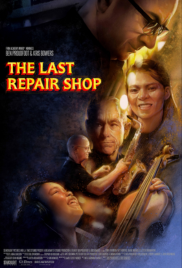THE SPOKEN SUMMATION
(There is also a musical summation performed by alumni of the LAUSD music program.)
[The Young Violinist:] “I love the violin” … [Dana Strings:] I think a lot of people see a broken thing, and they just think it’s broken. It could be anything. Maybe, it’s public schools. [Steve Piano:] Or, maybe it’s the United States or any other part of the world. [Duane Woodwinds:] Maybe, it’s just a $20 fiddle found at a swap meet. [Dana Strings:] But when we see a broken thing, we think, “Oh! With a little something here, a little something there, we can fix the part that’s broken and make things whole again.” [Paty Brass:] It’s difficult work. [Steve Piano:] But no matter what, you do whatever it takes because [Dana Strings] fixing stuff is one of the best things that humans can do. [Steve Piano:] That’s why this is not just a musical instrument repair shop. When the instrument breaks, there’s a student without an instrument. No, no, no, not in our city.” [Duane Woodwinds] We know it could change their whole life. [Paty Brass] Even if they don’t know me, I’m part of that. [34:20 – 36:30]
The Official Trailer consists of the summation and can be easily shown to classes. Click here.
Co-Director Kris Bowers went to LAUSD schools and grew up playing on pianos tuned and repaired by Steve Bagmanyan (“Steve Pianos”). Bowers is a working Hollywood composer with credits for movies such as Origin,Green Book, Bob Marley: One Love, and The Color Purple (2023)
A transcript of Dana String’s story is set out below. It is nothing less than profound. It was unscripted but even the best script writer in Hollywood could not have done better. The score that accompanies Dana’s story is excellent and it is best simply played to the class at 3:20 – 7:49.
“When the wood breaks, it breaks in a unique way and if you leave a crack open, the instrument buzzes. It can be really frustrating. It’s hard to find that last little buzz in the cello. You find it and you’re like, “Oh good! It’s gone!”
“It’s really hard being a kid. Some of them come from a place of love and support and others come from huge dysfunction. The emotional broken things and the mental broken things are more difficult. You can’t glue that back together. That takes time and it takes care.
Well, by the time I was 27 or so I’d begun the process of coming out. It was 1975. You have to remember that this was a different time. Being gay wasn’t accepted. People were beaten in the street. People were bashed and killed. So, from 13 years on, I tried my best to not be. I tried to grow out of it. I tried to, you know, evolve beyond it. And it wasn’t happening, and I thought I was broken. That buzz in the cello. It became being either miserable, trying to be something I wasn’t, or be authentic and be shunned, ridiculed, beaten or just kill myself. You know, it was — it was getting to a point of crisis for me.
“My mother and father were both musicians and my mom taught me music is like swimming. The rhythm is constantly in the moment and if you stop, there’s no music. Whatever you do, don’t stop. Keep going — no matter how bad of a train wreck it is – just keep going. And don’t quit. Don’t give up. Persist! You know. And so, … I realized I had to accept it. I wasn’t broken. No need for fixing. And so, I decided to embrace it. Met my husband. We became dads. And we’ve been a couple for almost 23 years now. And so, I’m still here. Alive. Free to be kind, be loving, be authentic. So, it’s not easy being a kid, but we try to make at least the playing of the instrument part as good as it can be.”




